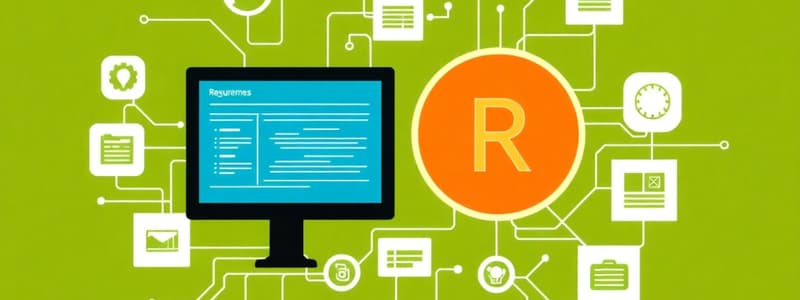Podcast
Questions and Answers
What is a key characteristic of iterative development?
What is a key characteristic of iterative development?
- System components are built incrementally over multiple iterations. (correct)
- Final products are delivered without any prior feedback.
- All components must be completed before testing.
- The entire system is developed in one continuous cycle.
How does iterative development aid in risk management?
How does iterative development aid in risk management?
- By implementing changes only after the final product is released.
- By focusing on larger project segments.
- By not requiring feedback from users.
- By allowing for the early identification of potential issues. (correct)
Which of the following is an advantage of iterative development?
Which of the following is an advantage of iterative development?
- It accommodates for evolving system requirements. (correct)
- It minimizes the need for ongoing testing.
- It requires all development to be completed at once.
- It guarantees the project will be completed on time.
What role does feedback play in the iterative development process?
What role does feedback play in the iterative development process?
Which statement correctly defines iterative development?
Which statement correctly defines iterative development?
What is the first step in the analysis process?
What is the first step in the analysis process?
During stakeholder analysis, which group is NOT typically considered a relevant stakeholder?
During stakeholder analysis, which group is NOT typically considered a relevant stakeholder?
What should feedback loops aim to achieve during system development?
What should feedback loops aim to achieve during system development?
Which elements should be included in the technology stack for a project?
Which elements should be included in the technology stack for a project?
What is the purpose of analyzing business processes within an information system?
What is the purpose of analyzing business processes within an information system?
Which type of requirements are specifically aimed at the needs of users and stakeholders?
Which type of requirements are specifically aimed at the needs of users and stakeholders?
What is a potential issue to identify when analyzing data within an information system?
What is a potential issue to identify when analyzing data within an information system?
What primary questions should be addressed when defining objectives?
What primary questions should be addressed when defining objectives?
What does systems analysis focus on?
What does systems analysis focus on?
Which step is NOT part of the systems development methodologies mentioned?
Which step is NOT part of the systems development methodologies mentioned?
What is a defining characteristic of a project?
What is a defining characteristic of a project?
What type of analysis helps to identify gaps between current and desired states?
What type of analysis helps to identify gaps between current and desired states?
Which methodology step involves capturing the vision for the information system?
Which methodology step involves capturing the vision for the information system?
Which characteristic is NOT typically associated with projects?
Which characteristic is NOT typically associated with projects?
What does systems design primarily focus on?
What does systems design primarily focus on?
What is a reason that a project may not be needed when developing a new system?
What is a reason that a project may not be needed when developing a new system?
What is the first activity in the Systems Development Lifecycle (SDLC)?
What is the first activity in the Systems Development Lifecycle (SDLC)?
Why is the Agile methodology preferred for certain projects?
Why is the Agile methodology preferred for certain projects?
Which of the following is NOT a characteristic of Agile development?
Which of the following is NOT a characteristic of Agile development?
What role does customer collaboration play in Agile development?
What role does customer collaboration play in Agile development?
Which methodology is most suited for projects with clear requirements from the beginning?
Which methodology is most suited for projects with clear requirements from the beginning?
What is the primary benefit of Agile methodologies?
What is the primary benefit of Agile methodologies?
What is the primary purpose of the planning phase in the SDLC?
What is the primary purpose of the planning phase in the SDLC?
Which of the following best describes a methodology?
Which of the following best describes a methodology?
What is an application in the context of software development?
What is an application in the context of software development?
What is the primary focus of an information system?
What is the primary focus of an information system?
Which of the following best describes the key difference between an application and an information system?
Which of the following best describes the key difference between an application and an information system?
Which foundation is crucial for understanding how a system will be used?
Which foundation is crucial for understanding how a system will be used?
What element helps avoid scope creep in software projects?
What element helps avoid scope creep in software projects?
What is included in the high-level architecture of a system?
What is included in the high-level architecture of a system?
Which aspect is essential to consider during the problem definition phase?
Which aspect is essential to consider during the problem definition phase?
What does the iterative development process emphasize?
What does the iterative development process emphasize?
Flashcards
Application
Application
A single software program designed to perform a specific task or solve a specific problem for its users. It typically focuses on a single function or set of related functions.
Information System
Information System
A broader concept that includes multiple components working together to collect, process, store, and distribute information. It often integrates applications, hardware, data, people, and processes to support decision-making and organizational objectives.
Problem Definition
Problem Definition
The process of identifying and defining the problem that a system aims to solve. This helps to avoid scope creep and keeps the project focused.
User-Centered Design
User-Centered Design
A design approach that puts the user at the center of the development process, considering their needs, goals, and preferences. It aims to create a system that is easy to use and understand.
Signup and view all the flashcards
System Architecture
System Architecture
A high-level outline of the components and structure of a system. It defines how different parts of the system will interact and work together.
Signup and view all the flashcards
Systems Development Lifecycle (SDLC)
Systems Development Lifecycle (SDLC)
The process of developing software that involves a series of predefined stages, including planning, analysis, design, development, testing, deployment, and maintenance.
Signup and view all the flashcards
Iterative Development
Iterative Development
A software development approach that breaks down the project into smaller, manageable iterations. Each iteration delivers a working version of the software, allowing for feedback and adjustments throughout the development process.
Signup and view all the flashcards
Agile Development
Agile Development
A way of developing software where the development team starts with a rough idea and gradually refines and improves the product based on feedback.
Signup and view all the flashcards
Stakeholder Analysis
Stakeholder Analysis
Identifying all individuals or groups who have an interest in or are affected by the system being analyzed.
Signup and view all the flashcards
Use Case Scenarios
Use Case Scenarios
Creating realistic scenarios of how users will interact with the system to understand its functionality and integration into their workflows.
Signup and view all the flashcards
Architectural Model
Architectural Model
Choosing the appropriate architecture (cloud-based, client-server, or hybrid) based on factors like ease of use, accessibility, and scalability.
Signup and view all the flashcards
Technology Stack
Technology Stack
Selecting and integrating the necessary technologies (programming languages, databases, frameworks, etc.) based on project needs and team expertise.
Signup and view all the flashcards
Define Objectives
Define Objectives
Establishing clear objectives and goals for the analysis, outlining what is being addressed or explored.
Signup and view all the flashcards
Analyze Business Processes
Analyze Business Processes
Analyzing existing business processes to identify areas of inefficiency, bottlenecks, or opportunities for improvement.
Signup and view all the flashcards
Analyze Data
Analyze Data
Examining data within the system to identify quality issues, redundancy, or inconsistencies.
Signup and view all the flashcards
Identify Requirements
Identify Requirements
Defining the specific information system needs, including functional requirements (what it must do), non-functional requirements (how it should work), and stakeholder-specific requirements.
Signup and view all the flashcards
Systems Analysis
Systems Analysis
The process of understanding and documenting what an information system should achieve.
Signup and view all the flashcards
Systems Design
Systems Design
The process of planning and describing in detail how an information system will solve a problem.
Signup and view all the flashcards
Project
Project
A temporary undertaking with a defined scope, timeline, and resources to achieve a specific outcome.
Signup and view all the flashcards
Systems Development Methodology
Systems Development Methodology
A structured approach that provides tools and techniques for developing information systems.
Signup and view all the flashcards
Gap Analysis
Gap Analysis
The difference between the current state of an information system and the desired future state.
Signup and view all the flashcards
Requirements Gathering
Requirements Gathering
A formal process used to gather information and opinions from users and stakeholders about an information system.
Signup and view all the flashcards
System Design
System Design
The process of translating the requirements into a detailed, functional design for an information system.
Signup and view all the flashcards
Implementation
Implementation
Developing prototypes, testing, and implementing the information system.
Signup and view all the flashcards
System Development
System Development
The process of analyzing an organization's need and developing a system to address it.
Signup and view all the flashcards
Methodology
Methodology
A systematic and structured approach or framework that guides a process, activity, or set of tasks to achieve specific goals or outcomes.
Signup and view all the flashcards
Best Practices
Best Practices
Established techniques or approaches proven effective in achieving specific goals or solving particular problems.
Signup and view all the flashcards
Waterfall Method
Waterfall Method
A development method that prioritizes clear requirements upfront and progresses in a linear fashion through distinct stages.
Signup and view all the flashcards
Agile
Agile
A system development process that prioritizes flexibility and responsiveness to change; allows teams to adapt to new requirements during development.
Signup and view all the flashcardsStudy Notes
Software Requirements Analysis and Design
- The course ACS2913 covers software requirements analysis and design principles, focusing on an overview of systems analysis and design.
- The lecture overview includes software development and systems analysis and design, systems development lifecycle, iterative development, a sample project (developing RMO's tradeshow systems), with an introduction to Ridgeline Mountain Outfitters sourced from a textbook.
Applications and Information Systems
- Software development can refer to applications—single programs designed for specific tasks.
- Example: Microsoft Word
- Software development can also refer to information systems -broader encompassing multiple components (hardware, data, people, processes) for comprehensive information management and support in decision-making.
- Example: University Learning Management Systems (LMS) like Moodle.
- Applications are standalone tools, while information systems are intertwined ecosystems combining multiple tools for a wider purpose.
Key Foundations for Building an Information System
- Understand the problem: Define the problem clearly, avoid scope creep, and identify all relevant stakeholders (users, management, customers) to understand their needs and perspectives.
- Understand how the system will be used: Employ user-centered design, focusing on user interaction (goals, behavior, preferences), ease of use and accessibility. Identify and document use cases and user stories to illustrate essential system functions and integrate them into user workflows. Continuous user feedback is imperative throughout development.
- Conceptualize the system's structure: Develop a high-level system architecture outlining components' interaction and considering hardware/software approaches (cloud-based, client-server, or hybrid). Select the appropriate tech stack (programming languages, databases, frameworks) based on project requirements and team expertise.
Ready to Begin Analyses
- Define Objectives: Establish clear goals and objectives for the analysis. Determine issues or opportunities related to the analysis.
- Identify Stakeholders: Identify all stakeholders (users, management, IT staff, external partners) affected in or by the information system.
- Gather information: Collect documentation related to the information system; interview key stakeholders and users; distribute surveys to gather quantitative data.
- Analyze business processes: Evaluate business processes the information system supports, highlighting bottlenecks and areas for potential enhancements. This involves analyzing data within the system, checking for data quality issues, redundancy, and integrity problems.
- Define requirements: Outline functional, non-functional, and stakeholder-specific requirements.
- Gap analysis: Compare the current state of the information system against the desired future state to identify necessary changes or improvements.
Systems Development Lifecycle
- SDLC: A complete process that involves all activities for building, launching, and maintaining an information system.
- The course will cover 6 core processes within the SDLC, which will be elaborated in detail in Chapter 1.
- The 6 core processes include: identifying the problem or need and obtaining approval, planning and monitoring the project, discovering the details of the problem or need, creating system components to solve the problem or meet the need, building, testing and integrating system components, completing system testing, and deploying the solution.
Methodology
- Methodologies (systematic and structured frameworks) that guide the process of solving problems or achieving goals.
- Example Methodologies:
- Waterfall Method: Best suited for projects with clearly defined up-front requirements.
- Agile Method: More suitable for projects with evolving requirements, allowing for iterative development and ongoing user feedback.
- Most current methodologies utilize Agile and iterative development methods.
Agile Development
- Agile prioritizes flexibility, responsiveness to change, and adaptation to new requirements.
- Agile Development's Key Characteristics: Flexibility, quick responses to change, customer collaboration, and early and continuous delivery.
- Benefits of Agile: increased adaptability, early/continuous delivery, and enhanced customer satisfaction due to collaboration.
Iterative Development
- Iterative Development: A process of building a system incrementally and in sections. Each section is refined over multiple iterations.
- Features of Iterative Development: Build-and-Refine Approach, Continuous Improvement and Feedback-Driven.
- Advantages of Iterative Development: mitigation of risk by using smaller, manageable portions of the system, early identification of potential problems, allowing adjustments as needed, adapting to evolving user feedback and project requirements.
Iterative and Agile SDLC
- Detailed visual representation of iterative and Agile SDLC, illustrating the core processes and iterations.
Course Summary
- The course focuses on developing information systems to address organizational needs using the System Development Lifecycle (SDLC) methodology.
- Key terminology includes information systems, computer applications, project, systems analysis, system design, and the System Development Lifecycle process. This also includes the information system development process, agile development, and iterative development.
Studying That Suits You
Use AI to generate personalized quizzes and flashcards to suit your learning preferences.




